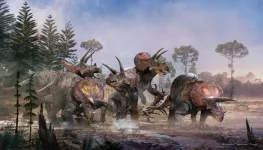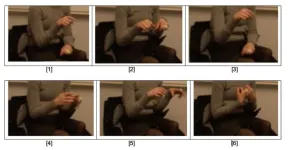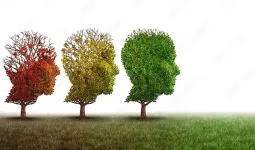(Press-News.org) ITHACA, N.Y. – An international team of 25 scientists has proposed a roadmap for how to prevent the next pandemic by conserving natural areas and promoting biodiversity, thereby providing animals with enough food, safe havens and distance to limit contact and the transfer of pathogens to humans.
Pandemics begin when disease-harboring animals, such as bats, come in close proximity with people, livestock or other animals and pass on new pathogens. Viruses such as SARS-CoV-2, SARS-CoV-1, Nipah, Hendra and possibly Ebola have all fatally spilled over from bats to humans, sometimes through an intermediate host.
“The world is focused on how can we detect and then contain a novel pathogen once it is circulating in humans, rather than how can we prevent that pathogen from entering the human population in the first place,” said Raina Plowright, professor in the Department of Public and Ecosystem Health at Cornell University, and first author of the paper, “Ecological Countermeasures to Prevent Pathogen Spillover and Subsequent Pandemics,” published in Nature Communications.
The pandemic-prevention strategy is based on insights from a pair of 2022 papers that serve as a case study applicable to all animals that potentially carry zoonotic diseases. Those papers – about how bats can spread fatal Hendra virus to horses and people – explained that when bats lose their natural habitats and winter food sources, their large populations splinter and they migrate in small groups to agricultural and urban areas. They also become stressed, partly due to inadequate food sources, and they shed more virus in their urine. The virus falls to the ground where grazing horses become infected; horses in turn can then infect people. But when natural habitats can provide adequate food, especially in fallow winter months, the bats return to these habitats, aggregate in large numbers, and stop shedding virus.
The roadmap uses this and other case studies to explain the mechanisms linking environmental change and spillover of pathogens from animals to humans, and identifies ecological interventions to disrupt these links and policy frameworks to implement them.
Ecological interventions begin by protecting the places where animals eat. “We need to make sure there’s always an abundant supply of food available at all times of year, especially when animals are in stressful life history stages like reproduction and migration,” Plowright said.
Next, it’s important to protect where animals may roost or aggregate, as tens of thousands of bats can roost in canopies and caves, so when these areas are disturbed, these populations can splinter, move and shed more virus. Also, cave dwelling bats may not have other caves to move to, in which case they stay put, become more stressed and likely shed more virus. Protecting lands that act as buffers between people and wildlife is also key.
“There are trillions of microbes in nature, but we rarely actually get sick, because there are many, many barriers between us and new pathogens,” Plowright said.
Lastly, for communities who come in contact with animals, it’s important to ensure people have the protection that they need to avoid pathogen exposure, Plowright said.
The study’s authors emphasize the need for an international agency or panel that can assess and synthesize data on pandemic prevention, preparedness and response and collect metrics on intactness of landscapes, ecological integrity and biodiversity.
The paper was funded by the Cornell Center for Pandemic Prevention, Preparedness and Response, the National Science Foundation, the Defense Advanced Research Projects Agency, the National Institutes of Health, the Montpellier Advanced Knowledge Institute on Transitions and the National Environment Research Council.
END
New roadmap to prevent pandemics centers on protecting biodiversity
2024-03-26
ELSE PRESS RELEASES FROM THIS DATE:
New maps help decision-makers factor albedo into tree-planting decisions
2024-03-26
Arlington, VA – As efforts to restore tree cover accelerate to help avoid runaway climate change, a new study highlights how restoring tree cover can, in some locations, heat up the Earth rather than cool it by affecting how much sunlight the surface reflects (i.e. “the albedo").
This new study by researchers at Clark University in the United States alongside scientists from The Nature Conservancy (TNC) and ETH-Zurich, published today in the journal Nature Communications, provides a global analysis of where restoration of tree cover is most effective at cooling the global climate system, considering ...
The construction of visual attention highlighted at the neuronal level
2024-03-26
In a world inundated with a constant stream of new information—notifications, ads, emails, news—we often struggle to prevent our attention from being constantly hijacked by external events. But is it truly within our power to filter and select our perceptions? And why do we find ourselves so easily distracted?
“Exogenous attention, the cognitive process that allows a salient visual stimulus to impose itself on us, is automatic. When a colleague walks past our desk, our attention is diverted from our computer screen despite ourselves,” explains Tal Seidel Malkinson (University of Lorraine), ...
Spielberg was right: Triceratops teamed up
2024-03-26
Actually, the team from Naturalis Biodiversity Center in the Netherlands was looking for a Tyrannosaurus, that summer of 2013 in Wyoming. Instead, they found a Triceratops: the famous dinosaur with the three horns and the large neck frill. And then they found another one. And another one. And more. The dig turned into a project that would last for more than ten years.
All in all, they dug up 1200 bones and bone fragments, of at least five individuals. A team of professional and volunteer paleontologists ...
Young adults with migraine, other nontraditional risk factors may have higher stroke risk
2024-03-26
Research Highlights:
Nontraditional risk factors for stroke were significantly associated with the development of strokes in adults younger than ages 35 to 45.
Migraine was the most important nontraditional risk factor for stroke among both men and women, according to the study of adults in Colorado.
Embargoed until 4 a.m. CT/5 a.m. ET Tuesday, March 26, 2024
DALLAS, March 26, 2024 — Adults younger than 35- to 45-years old may have a higher risk of developing a stroke from nontraditional risk factors ...
New data offer reality check on blood-based colorectal cancer screening
2024-03-26
Bethesda, MD (March 26, 2024) – Modeling studies and expert consensus published today in the journals Gastroenterology and Clinical Gastroenterology and Hepatology shed new light on the promise and peril of liquid biopsy (blood tests) for colorectal cancer (CRC) screening that are currently in development.
“Based on their current characteristics, blood tests should not be recommended to replace established colorectal cancer screening tests, since blood tests are neither as effective or cost-effective, ...
Virginia Tech study considers ways to increase accessibility for all wildlife enthusiasts
2024-03-26
One in three birders experiences accessibility challenges to participation in birding, according to Virginia Tech researchers Emily Sinkular and Ashley Dayer.
“I like to think of our research as blending together two previously unconnected fields: disability studies and wildlife recreation,” said Sinkular, a Ph.D. student and lead author of the study published March 26 in the journal Human Dimensions and Wildlife. “There’s been quite a lot of research on disability and lots of research on birding, but very few researchers have combined these two topics together.”
The ...
From autism to Alzheimer’s: A large-scale animal study links brain pH changes to wide-ranging cognitive issues
2024-03-26
A global collaborative research group comprising 131 researchers from 105 laboratories across seven countries announces a groundbreaking research paper submitted to eLife. Titled "Large-scale Animal Model Study Uncovers Altered Brain pH and Lactate Levels as a Transdiagnostic Endophenotype of Neuropsychiatric Disorders Involving Cognitive Impairment," the study identifies brain energy metabolism dysfunction leading to altered pH and lactate levels as common hallmarks in numerous animal models of neuropsychiatric and neurodegenerative disorders, such as intellectual disability, autism spectrum disorders, schizophrenia, bipolar disorder, depressive disorders, and Alzheimer’s ...
Tiniest ‘starquake’ ever detected – new study
2024-03-26
An orange dwarf star has yielded the tiniest ‘starquakes’ ever recorded, measured by an international team of scientists.
Named Epsilon Indi, the star is the smallest and coolest dwarf star yet observed with solar-like oscillations – “starquakes” like those shown by the Sun. These oscillations provide indirect glimpses of stellar interiors – just as earthquakes tell us about Earth's interior – and so are important sources of information about the makeup of the star.
The measurements ...
Italians’ and Swedes’ gestures vary when they tell stories, which may show cultures think differently about narratives
2024-03-26
When we talk, we often use our hands in addition to words. Gesturing is a phenomenon that has been observed across languages and cultures. Some cultures are typically thought to use more gestures than others.
To find out if the deeply rooted stereotype of Italians gesturing more than other cultures is true, researchers in Sweden have examined the differences in gesture rate and function between Italians and Swedes who were telling a story to a friend.
“We show that Italians do gesture more than Swedes, which was expected,” ...
New treatment target identified for Alzheimer's disease
2024-03-26
Researchers at the University of Leeds and Lancaster University in the UK have identified a new potential target for the treatment of Alzheimer’s disease – PDE4B.
Alzheimer's disease is the leading cause of dementia and disability in old age. As the number of people diagnosed with Alzheimer’s disease is on the increase, new treatments are urgently needed to improve the quality of life for people living with the disease.
PDE4B is an enzyme inside cells that breaks down a molecule known as cyclic AMP, which regulates a range of cellular processes. Based on an Australian study that identified the ...




